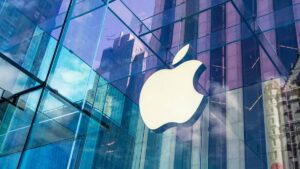Goldman Sachs tells clients to assume crash positions

Everything is fine. Via Getty.
Investment bank of the century Goldman Sachs is handing out pillows and telling passengers to assume crash positions as the global money train steams into a slippery and uncertain second half of ‘22.
Regardless of whether the broader economy wanders itself into recession, Goldman’s top man for US equity strategy David Kostin says his team now expects stifled revenue and tighter margins will trigger a slew of downward revisions to company earnings per share (EPS).
But as you’d expect when you travel in the bestest business class has to offer, the investment bank has no less than three safety strategies to protect clientele in case of emergency.
Wall Street’s worst dance since before disco
T’were a horrid six months for the Americans and their investors – overwhelmed by a bevy of bothers – from outright war in Europe to The Fed’s fight v inflation.
“The first six months of 2022 have been a brutal time to be an investor in public markets,” Kostin begins – which is never the best when you’re the investor and the guy writing is the one putting your cash in public markets.
After a decade of cheap money, low rates and bumptious investor enthusiasm for the imaginary major (and minor) US companies are long overdue a bit of a lesson in losing, the bank reckons.
Last month, after shares fell by 25% on weak quarterly margins, Kostin noted major players like Target (NYSE:TGT) cut margin guidance this week as it struggles to manage excess inventory. Investors have also focused on a string of downbeat comments from tech companies.
“Firms including Amazon (NASDAQ:AMZN,) (Microsoft (NASDAQ:MSFT), and Nividia (NASDAQ:NVDA) have signalled intentions to slow hiring. This development is positive in terms of balancing the labor market but reflects management anxiety about growth and inflation.”
And as those fears crystallise into a potential recession, Goldman has sent clients a three-pronged plan, saying it’s time to shift the cash into overweight spots across:
1. Healthcare stocks
Mr Kostin told clients Health Care has delivered notable EPS growth throughout every one of the last six American recessions and so far in this turbulent ’22, the S&P 500 healthcare names have fallen just 9.2%, compared to the more than 20% dive for the top 500.
In the current environment Goldman believes a robust and resilient healthcare has a few tailwinds going for it which are likely to deliver stronger performances from the sector in the medium-term.
“Health Care margins have exhibited minimal declines during past recessions trailing only Consumer Staples in terms of margin resilience.”
2. The companies with the most stable earnings growth
With US markets freshly mired in the newly minted bear market, Kostin wants clients to go with names which have a proven track record of earnings growth.
The S&P 500 has shed more than 20% since New Year, and while that’s still a big beat on say, the Nasdaq, or Tesla, the single sector to end the first half in the green on the broader market was energy.
“Environments of slowing economic growth and tightening financial conditions have historically supported the outperformance of stocks with ‘quality’ attributes,” Kostin says.
And unsurprisingly, Goldman actually has a basket for that – the Stable Growth basket!
Goldman’s Stable Growth basket cherry pickers look for stocks with the steadiest 10-year EBITDA growth with the lowest (realised and implied) price volatility.
Basically, it’s the best 50 Russell 1000 names with truly, stonkingly reliable EBITDA growth from over the last decade. According to CNBC analysts the custom Stable Growth basket has outperformed the S&P 500 by four percentage points year-to-date.
The custom-made basket for low volatility exposed names is down about 15.5% this year while the Goldman team under Kostin says the average stock trades at a 13% valuation premium to the median Russell 1000 stock.
It includes some of the mega American brands which are also likely to survive nuclear war. The Home Depot, Colgate-Palmolive and PepsiCo.
3. The best of dividend growth
When uncertainty takes over, the go-to certainty is a stable income. So Goldman recommends that for safety in volatility look for the best dividend-paying investments.
Goldman estimates dividend returns in the S&P 500 are accessible within a basket which contains dividend yields as high as Pioneer Natural Resources Co (NYSE: PXD) at $210.93 with an estimated dividend per share of 13.2%;
And as low as the fashion brand formerly known and loved as Coach, Tapestry Inc NYSE: TPR, at $30.64 with an estimated dividend per share of 3.9%.
Estimated 2023 dividend return per share, divided by current share price

According to Kostin, S&P 500 dividends fell by just 1% around the median recession since 1945. As a reliable source of income in times of economic recession, dividends provide consistency and regularity.
“(They) represent an attractive opportunity, even if a recession materialises in 2023,” he adds.
Goldman says since 1970, a sector-neutral strategy of owning companies with dividend yields in the highest quintile of their S&P 500 sectors has outperformed the index by 10 percentage points over a 12-month horizon – when headline consumer price index (CPI) was toppy – up around 6% and 7%.
Similarly, a strategy of owning the companies with the highest trailing 12-month dividend growth has outperformed the broader market, particularly when CPI was above 6%.
But best of all?
The shares which deliver Goldman’s golden combo of high dividend yield and growth.
UNLOCK INSIGHTS
Discover the untold stories of emerging ASX stocks.
Daily news and expert analysis, it's free to subscribe.
By proceeding, you confirm you understand that we handle personal information in accordance with our Privacy Policy.








